-
ENP 32.3 Big Bend: Travel Through Geological Time
08/11/2020For the third in our Big Bend National Park series, Bryan takes an epic trip through eons with Dr. Thomas Shiller, assistant professor of geology at Texas' Sul Ross University. From uplift to erosion, inland seas to volcanic action, the pair discuss this desert park's changing topography and its once-thriving dinosaur population. The hardest hitting questions, however, came from Everybody’s National Parks’ junior geologists, making this episode a real family affair.
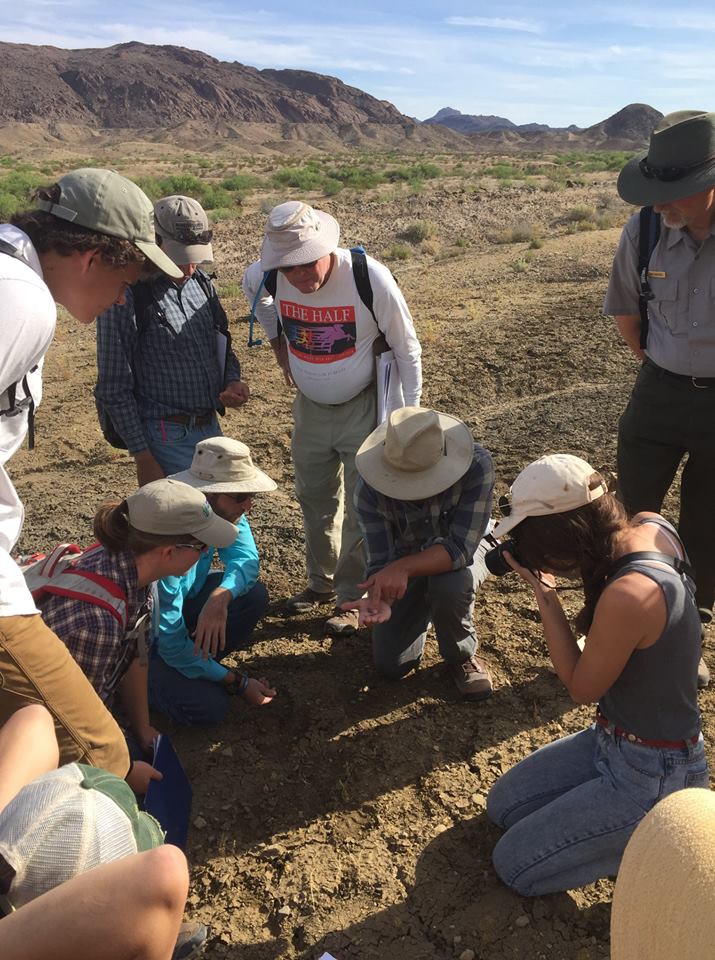 Sul Ross State University students learning about Cretaceous sharks of the Big Bend. Photo by Sam Cason.
Sul Ross State University students learning about Cretaceous sharks of the Big Bend. Photo by Sam Cason.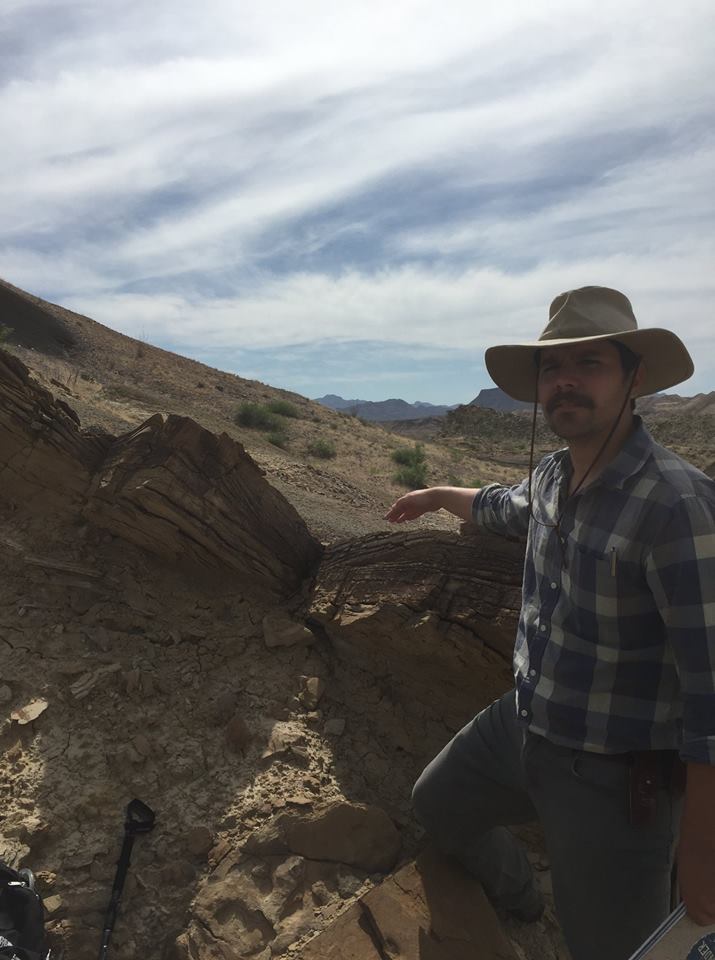 Shiller discussing the geologic history of the Late Cretaceous in Big Bend. Photo by Sam Cason.
Shiller discussing the geologic history of the Late Cretaceous in Big Bend. Photo by Sam Cason.Big Bend’s Complex Creation
There's no shortage of ancient stone in Big Bend National Park but if you're looking to lay hands on the oldest rocks, head to its northeast entrance, the access point from Marathon, TX. Once inside the park, these Paleozoic-era exposures, a series of curvy folded rocks, give way to younger Mesozoic-era stone and formations from that era's subdivisions, the Triassic and Cretaceous periods. All this to say that visitors to Big Bend will find themselves wrapped in 500 million years of geological evolution - a touchable timewarp perched at the edge of the Chihuahuan Desert.
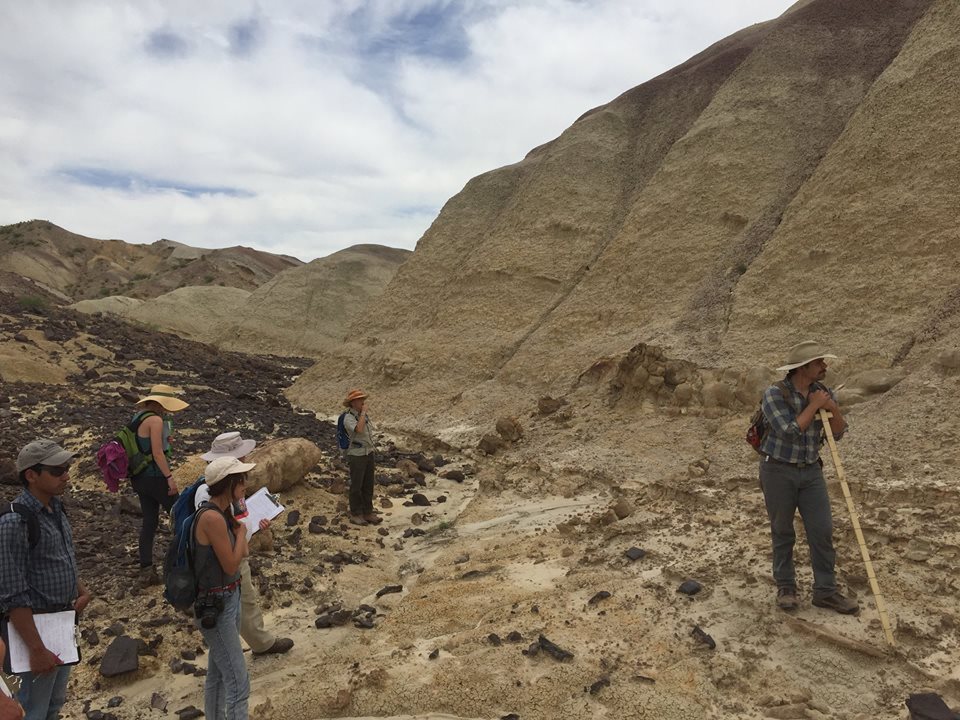 Sul Ross State University students visiting the historic excavation site of the giant flying reptile Quetzalcoatlus. Photo by Sam Cason.
Sul Ross State University students visiting the historic excavation site of the giant flying reptile Quetzalcoatlus. Photo by Sam Cason.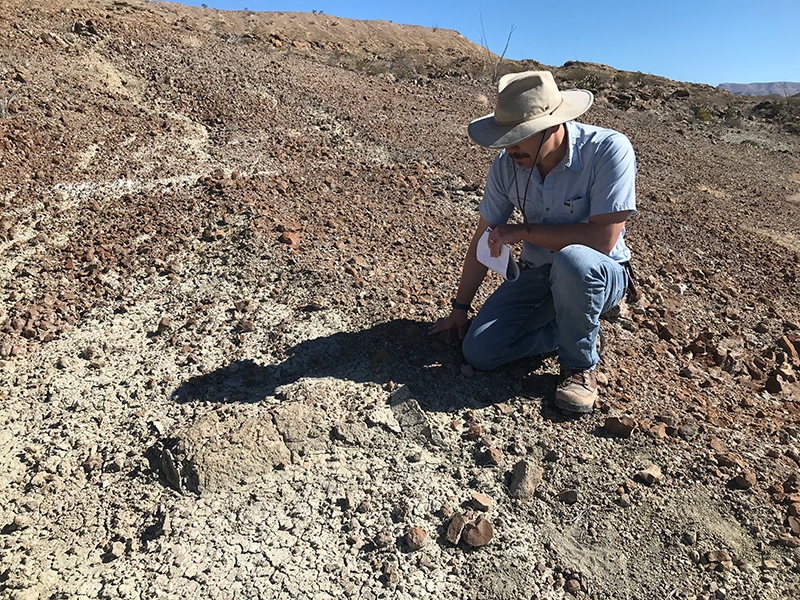 Shiller examining a large dinosaur vertebra. Photo by Jonathan Putnam.
Shiller examining a large dinosaur vertebra. Photo by Jonathan Putnam.By Land, By Sea, By Big Bend
But the most fascinating story of this wet desert environment belongs to its past life as part of the western interior seaway, home to deltas and dinosaurs. The once midland sea stretched from the Gulf of Mexico up through Canada, splitting North America in two, creating the perfect coastal climate for a dynamic array of land animals and aquatic creatures. This lush, fertile period deteriorated as water levels receded. The great extinction event followed, and then a geomorphic cycle which, Dr. Shiller says, eventually exposed the park's current contours. "Imagine having topography just like we see today with two big faults on either side of the park and then having that almost completely filled in with sediment over the course of a couple of million years. And then after another couple million years, that sediment is eroded down so that we have the topography that we see today when we visit the park."
Big Bend’s Fossil Finds
All that sediment did wonders for fossil preservation, an asset that Big Bend takes great pride in showing off at its fossil discovery exhibit. While most of the original specimens are housed elsewhere (think the final warehouse scene in Raiders of The Lost Ark), the reproductions on display are exquisitely faithful. The self-guided interpretive experience allows visitors to immerse themselves in details at their own pace. "If you ever visit the park, you absolutely need to go to the fossil discovery exhibit," Dr. Shiller says. "To me, as a paleontologist, as a geologist and as an educator, it is one of the best resources they have there."
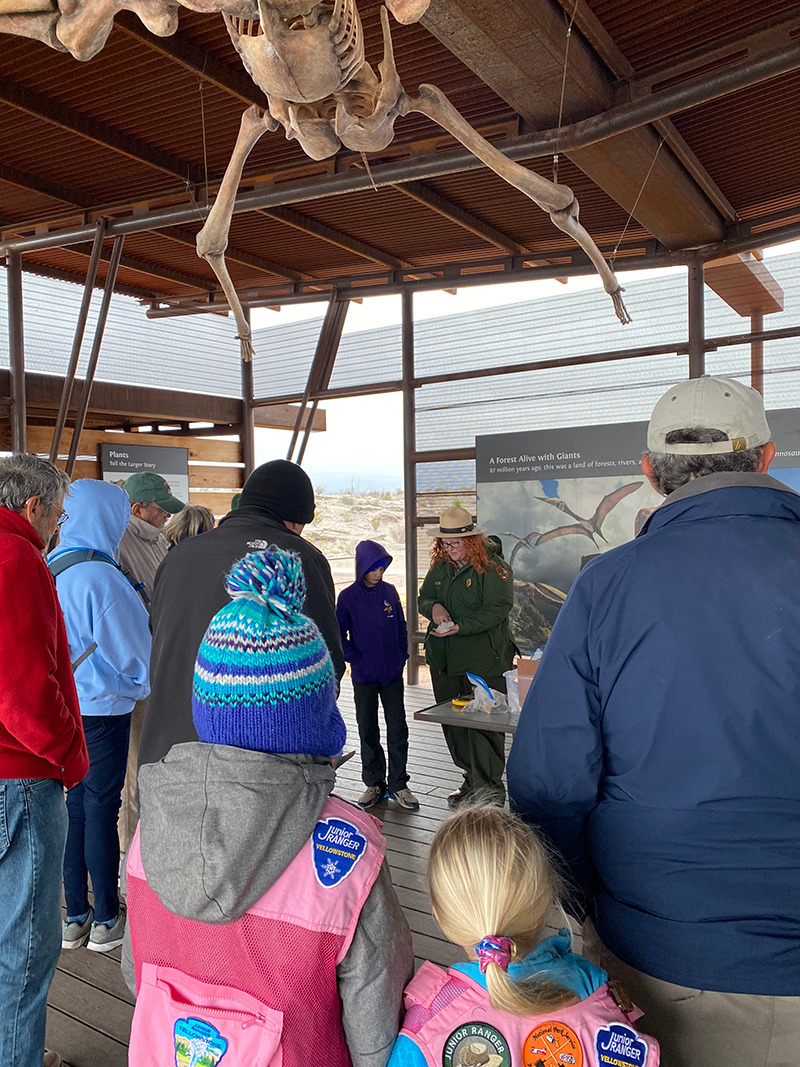 Attending Ranger Talk on Rocks and Bones
Attending Ranger Talk on Rocks and Bones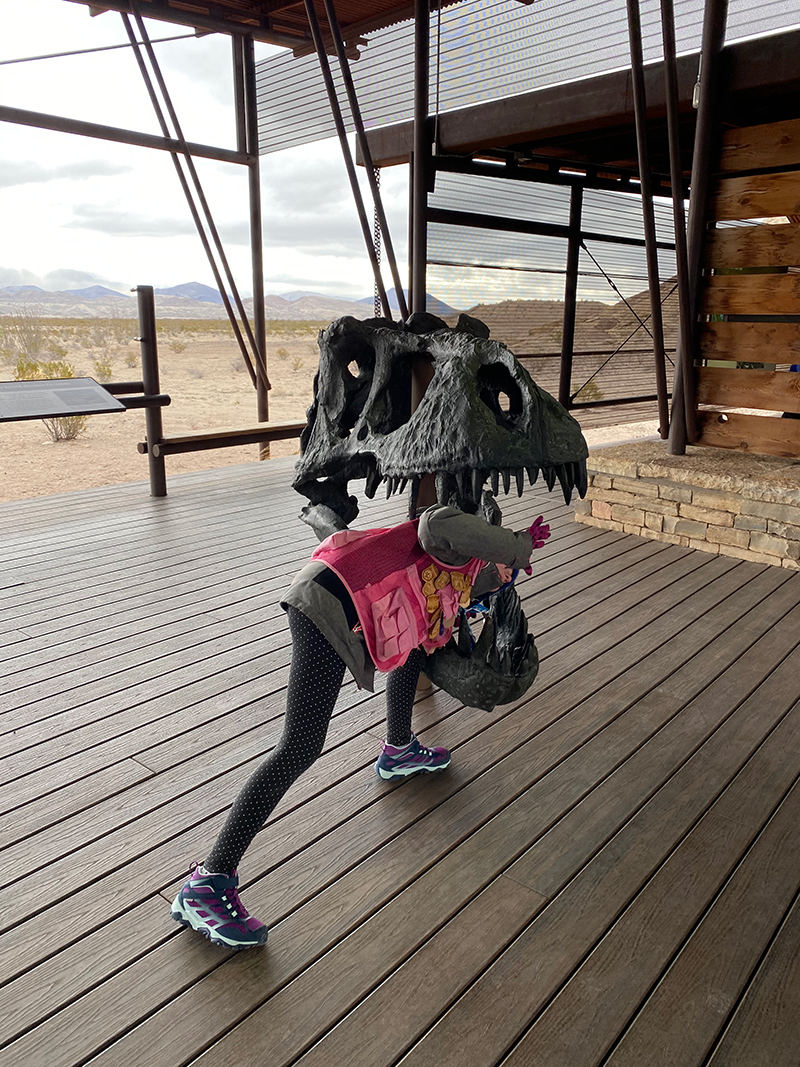 Junior Ranger eaten by a dinosaur
Junior Ranger eaten by a dinosaur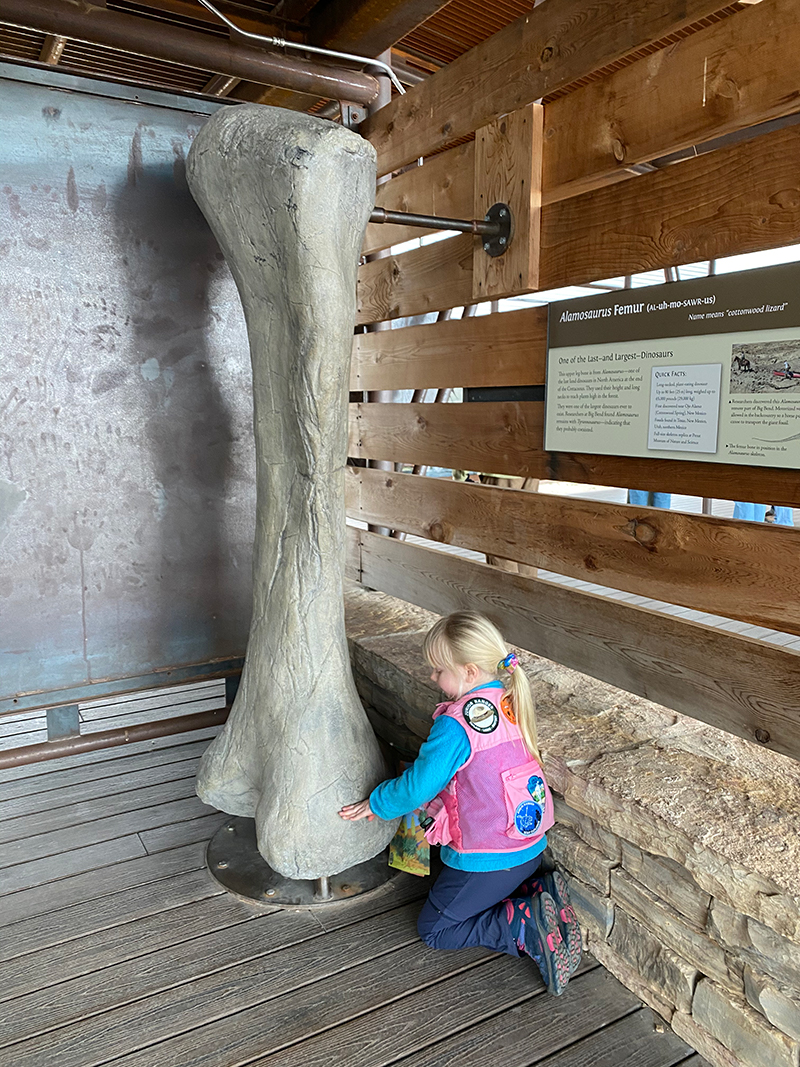 Upper leg bone from Alamosaurus - one of the last land dinosaurs in North America at the end of the Cretaceous.
Upper leg bone from Alamosaurus - one of the last land dinosaurs in North America at the end of the Cretaceous.Fossil Radio
Before handing the mic over to Everybody’s National Parks’ youngest correspondents, self-described "big kid" Bryan got the scoop on Science Knights In The Morning, a weekly radio show on KVLF hosted by Dr. Shiller, biologist Sean Graham, and quantum physicist Anirban Bhattacharjee. With a YouTube channel and Facebook page, the show is an excellent resource for anyone planning a visit to Big Bend or just a great way to play an armchair scientist.
You don't have to be an avid rock hound to enjoy Big Bend's spectacular, prehistoric scenery. Just being aware that you're standing in the basin of a once-mighty sea or walking the same trails as long-necked dinosaurs are enough to thrill your inner 10-year-old.
DUE TO COVID-19 PRECAUTIONS, BIG BEND NATIONAL PARK WAS IN PHASED REOPENING AT TIME OF PUBLISHING THIS EPISODE. PLEASE CHECK NPS WEBSITE FOR ACCESS UPDATES.
Discussion includes the following:
[00:02] Introduction: ENP Big Bend National Park Series, Dr. Thomas Shiller
[01:13] Geological timeline of Big Bend, Chisos Mountains, Santa Elena Canyon
[12:03] Night Skies program
[12:30] Big Bend: The once-great western interior seaway
[13:15] Big Bend’s rich deposit of fossils
[17:17] Digging deeper into the park’s Cretaceous Period
[17:40] Big Bend’s unique flora and fauna fossils
[19:50] Old school tricks of the geologist trade
[20:26] Big Bend fossil stewardship
[24:21] ENP Grand Canyon geology episode
[25:20] More Big Bend fossil stewardship: Paleo Lab at UT Austin
[26:33] Big Bend Fossil Discovery Exhibit
[30:30] Big Bend ranger programs
[30:53] Science Knights in the Morning: YouTube, Facebook, KVLF
[32:47] Missing time: Big Bend’s black conical hills and the great extinction event
[35:40] ENP’s junior correspondents take the mic (Part I): Western interior seaway facts
[35:46] ENP’s junior correspondents take the mic (Part II): A dinosaur census
Connect & Subscribe
You can find Everybody’s National Parks podcast on Instagram, Facebook and Twitter, and tag #everybodysnationalparks. Make sure to subscribe to Everybody’s National Parks wherever you get your podcasts, so you’ll never miss an episode.
Send us your stories, tips, or comments to Hello at everybodynps.com you can write us a message or even record a short voice memo on your phone, and then attach it to the email. You may be featured in an upcoming episode.
If you like the show, become a patron to support the show.
Most of all, enjoy exploring the national parks with your family.
player
Podcasts
